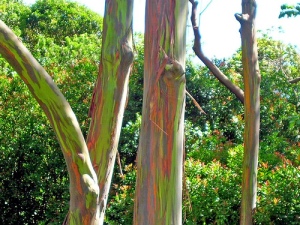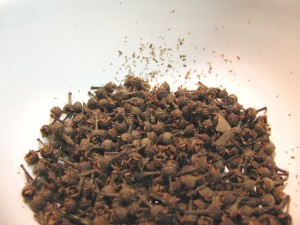Well known for its extremely peculiar bark, the Rainbow Eucalyptus can reach great heights (pun completely intended). Growing with an ovular shape once mature, Eucalyptus deglupta is reported to reach 76 meters tall. It is one of the fastest growing trees on the plant, with one strand in New Guinea reaching an average 54 meters tall and 2 meters wide at 14 years of age. Flowering can begin after only a few years of germination. The bark “sheds” in the summer, revealing a magnificient variety of copper, orange, brown, green, pink, and purple.
Eucalyptus deglupta (Rainbow Eucalyptus, Mindanao Gum)
Deciduous: no
Hardiness Zones: 10-11
Height: 30-76 meters (100-250 feet) tall
Diameter: 18-38 meters (60-125 feet) wide spread (including canopy and root system), the trunk reaches 1.8 meters (6 feet) wide in total
Growth Rate: VERY fast (in 18 months, one specimen reached 10 meters in height)
Age: typically 50-150 years
Root System: radial
Family: Myrtaceae
Subspecies: none discovered (yet)
Tolerates: highly alkaline soils, fairly high rainfall
Problems (major): entirely intolerant of frost, devastated by fires, prolonged marsh-like conditions can cause root rot
Problems (minor): beetle borers, root rot (in drenched soils), termites are especially harmful to young trees, requires sufficient planting space
Poisonous: not fully understood
Soil requirements: moderately wet soil, loamy or sandy, somewhat acidic or very alkaline
Air Requirements: high humidity, frequent rainfalls
Watering requirement: frequent watering neccessary
Sun requirement: full sun required
Needles: none
Cones (male): none
Cones (female): none
Leaves: lanceolate (lance-shaped), give off an aroma when crushed, dark green, up to 20 centimeters (8 inches) long and 10 centimeters (4 inches) wide
Flowers: tiny, white, showy, pollinated by bees
Fruits: very tiny, winged, dark brown once mature, release 3-12 seeds per pod
Seeds require stratification: Trees growing in colder climates require colder conditions (stratification) for some seeds to germinate. Consistently warm-weather Eucalyptus, however, don’t exhibit the need for a cold period. Optimal seed growth temperature, at least for the Eucalyptus growing in consistently warm-weathered areas, is 35 degrees Celsius (one of the highest worldwide).
Monoecious or Dioecious: Monoecious (each tree has male and female flower organs)
Notable characteristics:
This is the only type of Eucalyptus tree that natively grows in the northern hemisphere (including Costa Rica and the Philippines). The bark peels in the summer, giving this tree its characteristic coloring. However, the bark is less colorful outside of tropical areas.The Rainbow Eucalyptus, in addition to its colorful bark, is also one of the fastest growing trees worldwide.
Uses:
Occasionally used as charcoal, the Rainbow Eucalyptus’ wood is its major selling point. The wood is used for particleboard, boats, construction lumber, plywood, and many other options. This tree has been used to help reforest areas recently devastated by volcanic activity, landslides, or human deforestation. In the correct temperate zones, Eucalyptus deglupta is used as a street tree, a shade tree, a specimen tree, or an ornamental.
Sources used:
- http://selectree.calpoly.edu/treedetail.lasso?rid=536
- SelecTree. “Eucalyptus deglupta Tree Record.” 1995-2014. Feb 21, 2014. < http://selectree.calpoly.edu/treedetail.lasso?rid=536 >
- M. Ritter, W. Mark and J. Reimer (photographs)
- (These first three items all go together)
- http://www.missouribotanicalgarden.org/PlantFinder/PlantFinderDetails.aspx?taxonid=282890&isprofile=0&letter=e
- http://www.worldagroforestrycentre.org/sea/products/afdbases/af/asp/SpeciesInfo.asp?SpID=770
- http://botany.si.edu/pacificislandbiodiversity/hawaiianflora/speciesdescr.cfm?genus=Eucalyptus&species=deglupta
- http://webcache.googleusercontent.com/search?q=cache:bMRSxExiLzoJ:www.ctahr.hawaii.edu/forestry/trees/CommonTreesHI/CFT_Eucalyptus_deglupta.pdf+&cd=2&hl=en&ct=clnk&gl=us
- Williams, Jann E., and John Woinarski. Eucalypt Ecology: Individuals to Ecosystems. Cambridge: Cambridge UP, 1997. Print.
- http://eucalyptusdeglupta.com/
- http://www.exoticatropicals.com/tropical-trees/eucalyptus-deglupta-rainbow-eucalyptus/
 A gorgeous view of the bark and canopy
A gorgeous view of the bark and canopy
 Two Rainbow Eucalyptus trees that recently shed their bark
Two Rainbow Eucalyptus trees that recently shed their bark
 A large group of seeds and seed pods
A large group of seeds and seed pods
 A young sapling less than one year old
A young sapling less than one year old
I do not own the rights of these images; all credit goes to its original creator(s).


